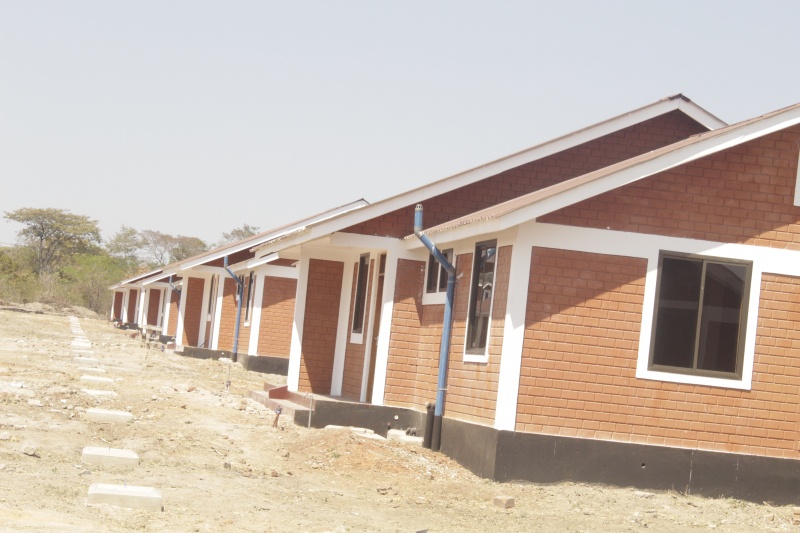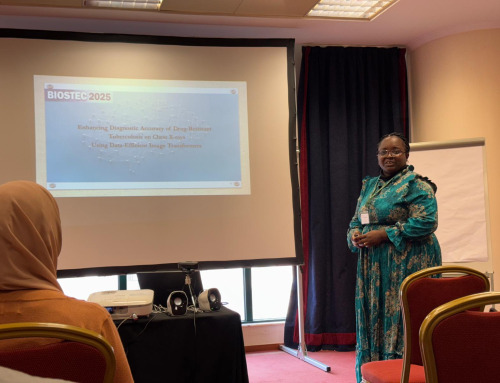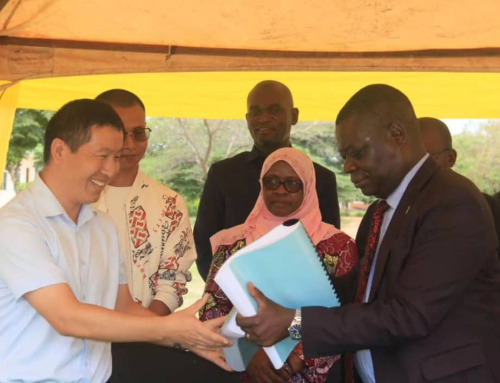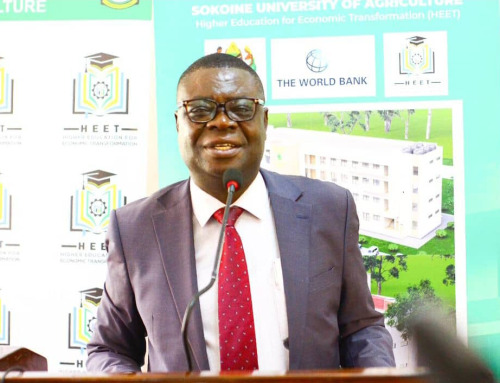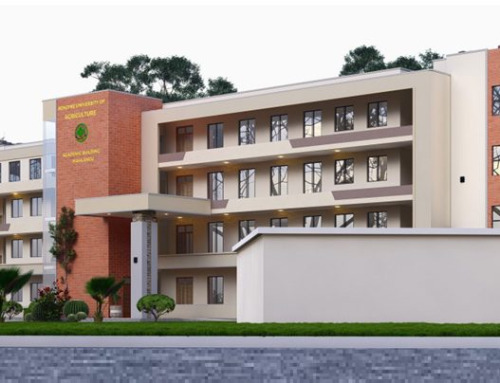EXECUTIVE SUMMARY
1. Introduction
The Sokoine University of Agriculture (SUA) is a public higher learning institution located in Morogoro, Tanzania. It was established on July 1, 1984, through Parliamentary Act No. 14 of 1984, with subsequent amendments. The university now operates under the SUA Charter of 2007 and the Universities Act of 2005. In 2020, SUA established the Mizengo Pinda Campus College in Katavi region to offer various degree and non-degree programs in Agriculture.
SUA has received funding from the Higher Education for Economic Transformation (HEET) Project (P166415) to support its strategic development plans. The project is backed by the Government of Tanzania and financed by the World Bank. SUA has directed about 11,044,550,000/= TZS (USD 4,418,261.80) for developing its existing MPCC located in Mpimbwe district, Katavi region. The project implementation is estimated to take 18 months after commencement. Its objective is to strengthen the learning environment and labor market alignment of priority programs at higher education institutions and improve the management of the higher education system. The HEET project focuses on seven strategic areas, including increasing enrollment capacity, upgrading learning resources, promoting research and innovation, building linkages with the private sector, strengthening the use of digital technology, promoting self-generated income, and building the capacity of academic staff and university leadership. To enhance enrollment capacity and research and innovation at the MPCC, SUA plans to use a portion of the funds to construct academic buildings, student hostels, and a cafeteria. These constructions aim to improve accessibility for individuals with special needs, address gender considerations, and enhance safety within the campus.
The World Bank employs the Environmental and Social Framework (ESF) alongside policies and standards to address expected social and environmental impacts in Investment Projects Financing. The ESF’s first standard (ESS1) outlines criteria for Borrowers to identify and assess these impacts, requiring the development of mitigation measures. In line with this, SUA submitted Environmental and Social Impact Assessment (ESIA) documents to the National Environmental Management Council (NEMC), including a Scoping Report and Terms of Reference (ToR). NEMC approved the ToR, assigning a Project Reference No. EC/EIA/2023/3511. The study adhered to local and World Bank environmental regulations and the project’s Environmental and Social Management Framework (ESMF).
2. Project Description and location
SUA-MPCC landscape is moderately flat terrain with gentle slopes and dominated by sandy clay loam soil-type. The built- up area of two buildings is found in the flat area about 80m from administration building where current administrative activities take place. The least developed area is found near the existing staff houses where current there is a farming activity. The proposed site is surrounded by commercial-residential buildings and exotic vegetation, households farming plots and perennial vegetation covers. Indigenous vegetation has been long cleared to pave way for anthropogenic activities. The proposed establishment of new buildings under HEET project will be done at the least developed area. The academic building and cafeteria will be constructed at flat area. However, the construction of hostel building may not necessitate the demolition of the staff quarter because there is an enough bare land for construction.
In Katavi Region, the MPCC is positioned below the equator, between latitudes -5.5‟ and 30.25‟, and longitudinally between -7.5‟ and 31.5‟ east of Greenwich. It is 1160 km from the Main campus in Morogoro, accessible via different roads. The MPCC is about 12 km north of Katavi National Park. Regionally, it is situated in Kibaoni village, Kibaoni ward at Mpimbwe District Council, approximately 70 km from Mizengo Pinda Bus Stand through the Sumbawanga Road, connecting it with the rest of Katavi region and inter-regional bus services to cities like Dar es Salaam, Kigoma, and Tabora.
3. Nature and The Main Project Activities
The project involves establishment of academic, cafeteria, and student hostel buildings in four phases: mobilization, construction, operation/maintenance and decommissioning. Planning activities include obtaining permits, surveys, feasibility studies, engineering designs, and environmental assessments. Construction activities encompass site establishment, worker mobilization, equipment and material transportation, camp construction, road clearing, excavation, and building structures. Decommissioning involves laying off workers, removing equipment, demolishing camps, restoring roads and areas, and re-vegetating cleared spaces.
4. Relevant Policies and Legislation
The proposed project at SUA-MPCC is subject to various policies, legislations, standards, regulations, and guidelines to ensure legal and regulatory compliance. These include policies such as
- The National Environmental Policy (2021) o Construction Industry Policy (2003) o National Land Policy (1997)
- National Gender Policy (2002), Energy Policy (2015) o National Water Policy (URT, 2002) o National Health Policy (URT, 2003) o Education Training Policy (2014) o National Mineral Policy (2009) o National Employment Policy (2008) o National HIV and AIDS Policy (2001), and among others.
Additionally, legislations and regulation were included in this report such as the o Environmental Management Act (2004) o Employment and Labour Relation Act (2004) o Urban Planning Act (2007)
- Occupational Health and Safety Act (2003) o Public Health Act (2009), Urban Planning Act (2007) o Fire and Rescue Act (2015)
- Workers Compensation Act (No.20), (2008)
- Universities Act No. 7 of 2005, The Education (Amendment) Act, 1995 o Standard Act of 2009 o Contractors Registration Act (1997) o Architects and Quantity Surveyors Act (1997) o Environmental Impact Assessment and Audit (Amendment) Regulations (2018),
Environmental Management (Air Quality Standards) Regulations, 2007 o Environmental Management (Soil Quality Standards) Regulations, 2007, o Environmental Management (Water Quality Standards) Regulations, 2007 o Environmental Management (Standards for Control of Noise and Vibration Pollution) Regulations, 2015.
The ESIA study aligns with the World Bank Environmental and Social Framework (ESF), promoting sustainable and inclusive development by enhancing safeguards for people and the environment. It addresses various aspects including labor, inclusion, non-discrimination, gender, climate change, biodiversity, community health, safety, and stakeholder engagement. HEET will adhere to 6 out of the 10 relevant Environmental and Social Standards (ESSs) set by the World Bank.
- ESS1: Assessment and Management of Environmental and Social Risks and Impacts.
- ESS2: Labor and Working Conditions.
- ESS3: Resource Efficiency and Pollution Prevention and Management.
- ESS4: Community Health and Safety.
- ESS8: Cultural Heritage
- ESS10: Stakeholder Engagement and Information Disclosure
The Environmental Impact Statement for the project will evaluate compliance with these policies, legislations, standards, regulations, and guidelines to ensure that the proposed development aligns with and abides by all relevant legal and regulatory requirements related to environmental management, health and safety, land use, and pollution control.
5. Baseline Data and Information
The proposed project area for project implementation has no variety of plants species except only grasses and few trees were observed. During general searches it was observed that there is no species of the amphibians and reptiles that are included in the IUCN Red list of threatened species. The plants species covered the project area it includes herbs, grasses, sunflower crops (Helianthus giganteus) and one trees species called Balanite aegyptiaca (Desert date).
Also, this show the measuring recommended parameters from the existing environment that will be used for monitoring practices during project construction and operation phases. For our proposed project, all measured parameters for particulate matter (PM10 and PM2.5), noxious gases, and noise for all sites of the proposed project were within permissible limits corresponding to limits prescribed by Local Standard (TBS limits) and international limits (WHO/IFC limit) for ambient air quality.
Furthermore, the project site boasts excellent accessibility to social amenities, such as road networks, church, school, water, electricity and telecommunication services for Vodacom only and limited to Tigo and Airtel. SUA-MPCC and the neighboring communities offer convenient access to financial services, including mobile money and banking facilities. This accessibility ensures that laborers working at MPCC can easily avail themselves of these services during both the construction and operational phases. Moreover, MPCC features a hospital that will be utilized for healthcare services throughout the construction and operation periods. The proposed project at SUA-MPCC may lead to the raises of several social issues and potential impacts SUA-MPCC
Students and residents from Kibaoni ward which includes but not limited to the following; o The project is expected to bring in an influx of people, including construction workers, leading to a temporary increase in the local population. This could strain existing resources and infrastructure. o The construction phase is likely to lead to an increase in the local population due to the migration of contracted workers.
- The existing health infrastructure in Katavi region, with 2 health centers and 10 dispensaries, may face challenges in coping with the increased population during and after the construction phase.
- The spread of transmitted diseases is a significant challenge in institutions with high populations, and the introduction of new managerial methods, such as handwashing systems, sanitizers, distribution of condoms etc., should be implemented.
6. Stakeholders Engagement and Public consultations
The identification and engagement of stakeholders followed regulations from EIA and Audit Regulations (2005 and its 2018 amendment), World Bank Environmental and Social Standards (ESS10), and Stakeholders Engagement Plan (SEP). Public consultation involved sharing project information, understanding stakeholders’ concerns, and building community relationships. Key stakeholders were identified based on their role, relevance, influence, and potential impact on the project. The Stakeholders Engagement Plan (SEP) covered both national and sub-national levels, with a focus on sub-national stakeholders. It outlined engagement details related to project activities, including various stakeholders at regional, district, and village levels. The project aimed for inclusiveness, involving women, vulnerable populations, and people with special needs. Consultations were conducted throughout the project lifespan, and mechanisms were established to address grievances such as Gender-based Violence (GBV), Sexual Exploitation and Abuse (SEA), and Sexual Harassment (SH).
Stakeholders’ consultation was carried out during the scoping exercise to identify and respond to project issues of concern to stakeholders. Details of the meetings and focus group discussions with individuals and groups of stakeholders shall be appended in the EIS. Stakeholders consulted included all individuals or groups that might be affected or might affect (positively or negatively) the proposed development in one way or another. They are found at the Zonal, Regional, District, and local levels. At the Zonal level, OSHA was consulted. At the Regional level, the following stakeholders were consulted SUA-MPCC (Staff, Students, and Service Providers), Fire and Rescue Force, Rural Water Supply and Sanitation Agency (RUWASA), TANESCO, NGOs and CBOs, Mpimbwe District Council. At the local level, the ward executive officer (WEO) and village executive officers (VEO) as well as community members were consulted.
7. Impact Assessment and Identification of Alternative
The different stages of the project will bring about environmental and social outcomes. These outcomes will be observed during the mobilization, construction, demobilization, operation, and closure periods of the project. Among these outcomes, one of the most prominent and easily recognizable ones will be the contamination of the nearby environment, which will affect the water, land, air, and project life. Although the project will be enclosed within a fence, there is still a chance of direct or indirect effects on these elements as a result of the project’s implementation.
Some of the social and economic impact of the project
The following is a summary of the main positive impacts.
- Job Creation and employment opportunities
- Increased market opportunities and sources of income
- Increase of admission of students to SUA
- Increased Revenues to local authorities
- Disruption of social activities
- Increased skills and impart knowledge to local communities
- Growth of Trade and Increased Investment
- Increased commercial and social activities around project locations
- Influx of people
- Occupational Safety and Health impacts.
- Community Health, Safety and Security
- Conflicts and grievances
- Prevalence of Communicable diseases
- Increased level of crimes
- Child labour
- Loss of employment
- Loss of business opportunities
- Disruption of flow of traffic and public mobility.
- The growth of banking activities in the project area
- Increase pressure on social services and utilities.
Some of the environmental impact of the project
The following is a summary of the environmental impacts:
- Loss of vegetation due to exploitation of borrow pits/quarries and other natural resources
- Contamination and /impaired quality of receiving body – land and water
- Contribution to climate change
- Increased generation of solid and hazardous waste
- Generations of Solid and Hazardous Wastes
- Generations of Liquid Wastes
- Storm water generation and overflow
- Increased vibration
- Air pollution due to dust and gases emission.
- Increased Noise level
- Loss of vegetation
- Impact on natural resource (Energy and water)
- Erosion of Exposed Surfaces
- Increase storm water generation and overflow
- Loss of Visual Aesthetics
- Health and safety risks due to fire hazards
The current project site is actively engaged in delivering educational services and possesses suitable available land for the proposed project. The possibility of using an alternative location outside the campus will take into account the existing university land.
8. Mitigation Measures
SUA-MPCC is responsible for project execution and fulfilling environmental and social management responsibilities. The report contains plans and a monitoring strategy to minimize or prevent any negative social and environmental consequences. The Environmental and Social Management Plan (ESMP) described in the report chapter 7 outlines the schedule for implementing the suggested strategies to address these impacts, as well as plans for ongoing monitoring. It clearly establishes the roles and responsibilities of the parties involved in mitigating and monitoring the adverse environmental and social effects. Many of the mitigation measures put forward are essentially good engineering practice that shall be adhered to during all the project phases.
8. Environmental And Social Management Plan
The options to minimize or prevent the identified adverse social and environmental impacts as well as a monitoring plan have been suggested in this report and are contained in the ESMP as shown in Table 8.1. Many of them are based on good engineering and social practices. The ESMP defines roles and responsibility of different actors of the plan. However, the key actors during construction phase are contractor and Mizengo Pinda Campus College while during the operation phase, MPCC will be the key actor in implementation of mitigation measures. The associated environmental costs amount to TZS 315,000,000.
9. Environmental and Social Monitoring Plan
There will be four types of monitoring activities; i) baseline monitoring, ii) impact monitoring, compliance monitoring, and mitigation monitoring. The monitoring of environmental and social parameters during the construction phase shall be carried out by the Contractor’s safeguard team (i.e., Environmental, social and safety experts), under the supervision of the Consultant’s safeguard team. The responsibility for mitigation and monitoring during the operation phase will lie with the MPCC Estate Department. Depending on the implementation status and sensitivity of any emerging issues, OSHA and /or NEMC will perform annual EHS reviews in which environmental concerns raised will be reviewed alongside project implementation. The estimated annual costs for carrying out the proposed environmental motoring programme amounts to TZS 59,000,000.
10. Cost Benefit Analysis
The Environmental and Social Impact Statement (EIS) assesses the project by examining the detrimental effects it may have, taking into account the socioeconomic advantages that would be lost if the project did not proceed. The evaluation of the environmental cost-benefit ratio considers both the negative and positive impacts. Despite the project’s potential financial and social benefits, the environmental consequences can be effectively alleviated. The financial resources necessary for mitigating the adverse effects are relatively minimal in comparison to the overall investment required.
11. Decommissioning
Decommissioning will occur in the far future, hence the precise circumstances for mitigation are typically unpredictable. As a result, precise mitigation strategies for the environmental effects of decommissioning activity cannot be recommended at this time with a high degree of assurance. A decommissioning plan that considers environmental issues shall be prepared by the developer prior to the decommissioning works. Should it be done, decommissioning may entail change of use (functional changes), or demolition triggered by change of land use.
12. Summary and Conclusion
Summary
Environmental and Social Impact Assessment (ESIA) for the proposed construction project at SUA-MPCC was conducted to evaluate the potential environmental and social consequences of the proposed project. The assessment considered various aspects such as land use, air quality, noise, water resources, biodiversity, cultural heritage, and community well-being.
During the ESIA process, a comprehensive analysis of the project’s potential impacts was undertaken. It was found that the construction and operation of the new buildings would have both positive and negative effects on the environment and local communities.
On the positive side, the project would provide additional facilities for students and faculty, enhancing the educational experience and academic programs at the university. The construction phase would generate employment opportunities and stimulate the local economy. The new buildings would also contribute to the development of infrastructure in the area.
However, the ESIA identified several potential negative impacts that need to be addressed and mitigated. These included land disturbance and habitat fragmentation during the construction phase, increased traffic congestion, noise pollution, and potential impacts on the local water resources.
The assessment also considered the potential disruption to the surrounding community, including noise and dust from construction activities. Several measures and recommendations were proposed to mitigate these potential negative impacts. These included proper waste management practices, dust and noise control measures during construction, and the implementation of water conservation strategies. The assessment also emphasized the importance of engaging with local communities and stakeholders throughout the project’s lifecycle, ensuring their concerns are addressed and their input is considered.
Conclusion
Generally, the ESIA report for the proposed building project at SUA-MPCC highlighted both the positive and negative impacts. By implementing the recommended mitigation measures and actively involving local communities, the project can minimize its adverse effects on the environment and social well-being. This assessment provides valuable guidance for decisionmakers, planners, and developers to ensure that the construction project proceeds in a sustainable and socially responsible manner.

